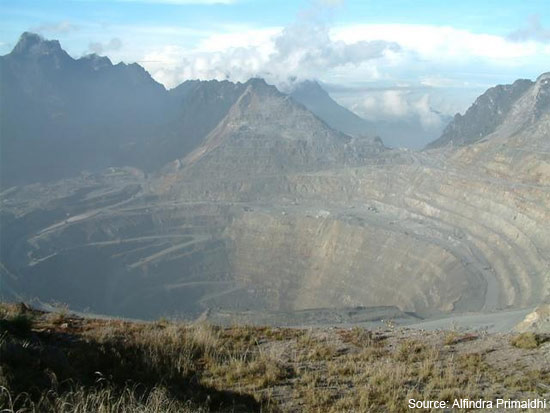Grasberg Open Pit, Indonesia
Located some 60 miles north of Timika, at Tembagapura in Irian Jaya – the most easterly of Indonesia's provinces – on the western half of the island of New Guinea, the Grasberg mine has the world's single largest known gold reserve and the second largest copper reserves.

The Grasberg Open Pit – originally a 4,100m-high mountain, which has been mined down to 3,000m.
Copper is the primary commodity, with a proven and provable reserve of 2.8 billion tonnes of 1.09%. The reserves also contains 0.98g/t gold and 3.87g/t silver.
Ownership belongs to Freeport McMoran Copper & Gold (67.3%), Rio Tinto (13%), Government of Indonesia (9.3%) and PT Indocopper Investama Corporation (9.3%). Around 18,000 people work at the mine, which is operated by PT Freeport Indonesia, a subsidiary of Freeport McMoran Copper & Gold.
To support the mine and its workforce PT Freeport has built an airport, a port at Amamapare, 119km of access road, a tramway, hospital, housing, schools and other facilities.

Mine vehicles on the access road; the mine operates a fleet of nearly 170 haul trucks
GRASBERG GEOLOGY
The mine stands at the collision of the Indo-Australian and the Pacific tectonic plates. Two distinct phases of intrusion have led to the production of nested coaxial porphyry ore bodies and sulphide rich skarn at the margins, while sedimentary strata includes Eocene clastic carbonate limestone with siltstones and sandstones near the base.
The Dalam Diatreme (DD) forms the first intrusive stage, being highly fragmental and characterised by clasts and a matrix of dioritic composition.
“The open pit mine is a high-volume low-cost operation, producing more than 67 million tonnes of ore.”
Mineralisation is largely disseminated and chalcopyrite dominant, having average grades of 1.2% copper and 0.5 g/t gold.
The second intrusive stage, the Main Grasberg Stock (MG), is composed of non-fragmental, porphyritic monzodiorites, forming a quartz-magnetite dilational stockwork with veinlet controlled copper-gold mineralisation. This is a high-grade resource, with averages of 1.5% copper and 2 g/t gold.
There is also a third intrusive stage, associated with the South Kali Dykes, which was the final intrusion and the most weakly mineralised.
MINING
The workings comprise an open pit mine, an underground mine and four concentrators. The open pit mine – which forms a mile-wide crater at the surface – is a high-volume low-cost operation, producing more than 67 million tonnes of ore and providing over 75% of the mill feed in 2006.
Designed to be fully mechanised, using 6.2m3 Caterpillar R1700 load-haul-dump vehicles (LHDs) at the extraction level with a truck haulage level to the gyratory crusher, the Deep Ore Zone (DOZ) block cave mine is one of the largest underground operations in the world.
After 2004, when the DOZ mine averaged 43,600 tonnes/day a second underground crusher and additional ventilation were installed to increase daily capacity to 50,000 tonnes.
Ore from both operations is transported by conveyor to centralized mine facilities, feeding a combined daily average total of some 225,000t of ore to the mill and 135,000t to the stockpiles.
Production equipment includes 30m3–42m3 buckets, a 170-strong fleet of 70t–330t haul trucks, together with 65 dozers and graders, with radar, GPS and robotics used in the mine’s state-of-the-art slope-monitoring system.

A mine LHD
PROCESSING
Ore undergoes primary crushing at the mine, before being delivered by ore passes to the mill complex for further crushing, grinding and flotation. Grasberg’s milling and concentrating complex is the largest in the world, with four crushers and two giant semi-autogenous grinding (SAG) units processing a daily average of 240,000t of ore.
“This is a high-grade resource, with averages of 1.5% copper and 2 g/t gold.”
A flotation reagent is used to separate concentrate from the ore. Slurry containing 60-40 copper concentrate is drawn along three pipelines to the seaport of Amamapare, over 70 miles away, where it is dewatered. Once filtered and dried, the concentrate – containing copper, gold and silver – is shipped to smelters around the world.
The facilities at the port also include the PT Puncak Jaya coal-fired power station, which supplies the Grasberg operations.
THE FUTURE
With the open pit heading to be exhausted in 2015, arrangements are well underway for the planned transition to fully underground production. The geology includes nine ore bodies – the Deep Ore Zone, which is located immediately below the now depleted Intermediate Ore Zone, the underground Grasberg, Kucing Liar, Mill Level Zone, Deep Mill Level Zone, Ertsberg Stockwork Zone and Big Gossan.
"The Deep Ore Zone block cave mine is one of the largest underground operations in the world."
Since 2004, a Common Infrastructure project has been in progress to create access to these large and undeveloped underground ore bodies through tunnels some 400m deeper than the currently existing system. This will both enable the known ore to be exploited and allow the potential of associated prospective areas to be explored in the future.
Open stoping at Big Gossan is scheduled to begin production in 2008, followed by the Ertsberg Stockwork Zone block cave mining in 2009.
Grasberg and Mill Level Zone block caving is expected to start in 2016, with exploitation of Kucing Liar and the Deep Mill Level Zone commencing in 2024 and 2027 respectively.
| Attachment | Size |
|---|---|
| grasberg_pit.jpg | 45.24 KB |
| grasberg_vehicles.jpg | 44.16 KB |
| grasberg_truck.jpg | 44.31 KB |
- Editor1's blog
- Login to post comments